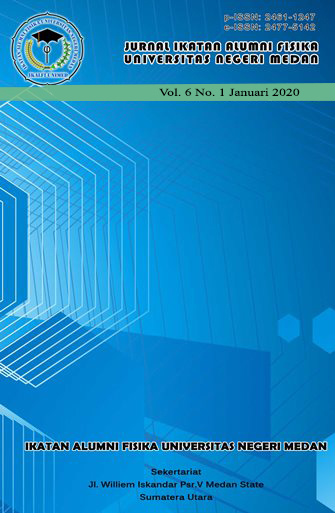PENGARUH MODEL PEMBELAJARAN INQUIRY TRAINING TERHADAP KETERAMPILAN PROSES SAINS SISWA PADA MATERI POKOK FLUIDA STATIS DI SMA NEGERI 11 MEDAN T.A 2018/2019
DOI:
https://doi.org/10.24114/jiaf.v6i1.18562Keywords:
Model Pembelajaran, Keterampilan Proses sains, fluida statis.Abstract
ABSTRAK Penelitian ini bertujuan untuk melihat perbedaan keterampilan proses sains siswa di SMA Negeri 11 Medan dengan menggunakan model pembelajaran inquiry training lebih baik dari pembelajaran konvensional.Penelitian ini menggunakan metode quasi experimental dengan desain penelitian Two Group Prete “Posttes design. Sampel kelas diambil dengan metode cluster random sampling. Sampel penelitian adalah kelas XI MIA-3 berjumlah 36 orang sebagai kelas eksperimen dan kelas XI MIA-1 berjumlah 36 orang sebagai kelas kontrol. Instrumen yang digunakan pada penelitian ini adalah tes keterampilan proses sains dalam bentuk essay dengan jumlah soal 10 buah yang telah dinyatakan valid oleh para ahli. Kemudian dilakukan Uji Normalitas, uji Homogenitas, dan uji-t 2 pihak terhadap hasil pretes kedua kelas untuk mengetahui kesamaan kemampuan awal siswa. Uji Normalitas kelas kontrol diperoleh Lhitung< Ltabel (0,1014< 0,1476) dan kelas eksperimen diperoleh Lhitung< Ltabel (0,1178< 0,1476) sehingga dapat disimpulkan bahwa data berdistribusi normal. Uji Homogenitas diperoleh Ftabel = 0,1,890 dengan kriteria pengujian homogenitas Fhitung < Ftabel yakni 0,9605<1,890 maka dapat dinyatakan bahwa kedua sampel memiliki varians yang sama. Uji-t 2 pihak thitung<ttabel (0,654<1,945), maka kemampuan awal siswa pada kedua kelas sama. Aktivitas keterampilan proses sains siswa diambil sesuai dengan rubrik menggunakan lembar observasi dan dilakukan oleh 1 orang observer.Setelah pembelajaran selesai selanjutnya dilakukan postest. Untuk hasil postest dilakukan kembali uji Normalitas, uji Homogeneitas, dan uji-t 1 pihak Uji hipotesis menggunakan uji-t satu pihak, hasil perhitungan statistik diperoleh nilai thitung sebesar 6,591 dan ttabel pada taraf signifikan 0,05 dan dk = 70 adalah 1,945 sehingga thitung > ttabel (6,591 > 1,945). Adanya perbedaan tersebut, berarti ada pengaruh model pembelajaran inquiry training terhadap keterampilan proses sains siswa pada materi fluida statis di kelas XI semester I SMA Negeri 11 Medan T.A 2018/2019.ABSTRACT This study aims to look at the differences in science process skills of students in Medan 11 Public High School by using training inquiry learning models better than conventional learning.This study uses a quasi experimental method with research design Two Group Prete “ Posttes design. Class samples are taken by cluster random sampling method. The study sample was 36 students in the XI MIA-3 class as an experimental class and 36 students in the XI MIA-1 class as a control class. The instrument used in this study is a test of science process skills in the form ofessays with a number of questions 10 pieces that have been declared valid by experts. Then performed the Normality Test, Homogeneity test, and t-test 2 parties on the pretest results of the two classes to find out the similarity of students' initial abilities. Normality control class test obtained Lhitung <Ltabel (0.1014 <0.1476) and experimental class obtained Lhitung <Ltable (0.1178 <0.1476) so that it can be concluded that the data is normally distributed. Homogeneity test obtained Ftable = 0,1,890 with testing criteria for homogeneity Fcount <Ftable which is 0,9605 <1,890, it can be stated that both samples have the same variance. The t-test for t-test is <ttable (0.654 <1.945), so the initial ability of students in both classes is the same. The activity of science process skills of students was taken in accordance with the rubric using observation sheets and carried out by 1 observer.After learning is complete, the next step is done. For the posttest results, the Normality test, Homogeneity test, and t-test are performed again. Test hypotheses using one-party t-test, the results of statistical calculations are obtained by tcount of 6.591 and t table at a significant level of 0.05 and dk = 70 is 1.945 so tcount > t table (6.591> 1.945). The existence of these differences means that there is an influence of the inquiry learning training model on science process skills of students in static fluid material in class XI of the first semester of SMA Negeri 11 Medan T.A 2018/2019.References
Aminah, S. dan Derlina. (2015). Efek Model Pembelajaran Inquiry Training dan Kemampuan Berpikir Logis terhadap Keterampilan Proses Sains. Jurnal Pendidikan Fisika. 2(2), 63-68.
Dimyanti dan Mudjiono. (2013). Belajar dan Pembelajaran. Jakarta: Rineka Cipta.
Sagala, S., (2012), Konsep dan Makna Pembelajaran, Alfabeta, Bandung.
Silitonga, P., Harahap, M. B dan Derlina. (2016). Pengaruh Model Pembelajaran Inquiry Training dan Kreativitas Terhadap Keterampilan Proses Sains. Jurnal Pendidikan Fisika. 5(1), 44-50.
Joyce, B. Weil, M & Calhoun, E. (2011).
Model-model Pengajaran Edisi Delapan. Yogyakarta: Pustaka Belajar.
Downloads
Published
Issue
Section
License
Copyright (c) 2020 JURNAL IKATAN ALUMNI FISIKA UNIVERSITAS NEGERI MEDAN

This work is licensed under a Creative Commons Attribution 4.0 International License.
Authors who publish with this journal agree to the following terms:- Authors retain copyright and grant the journal right of first publication with the work simultaneously licensed under a Creative Commons Attribution License that allows others to share the work with an acknowledgement of the work's authorship and initial publication in this journal.
- Authors are able to enter into separate, additional contractual arrangements for the non-exclusive distribution of the journal's published version of the work (e.g., post it to an institutional repository or publish it in a book), with an acknowledgement of its initial publication in this journal.
- Authors are permitted and encouraged to post their work online (e.g., in institutional repositories or on their website) prior to and during the submission process, as it can lead to productive exchanges, as well as earlier and greater citation of published work (See The Effect of Open Access).

